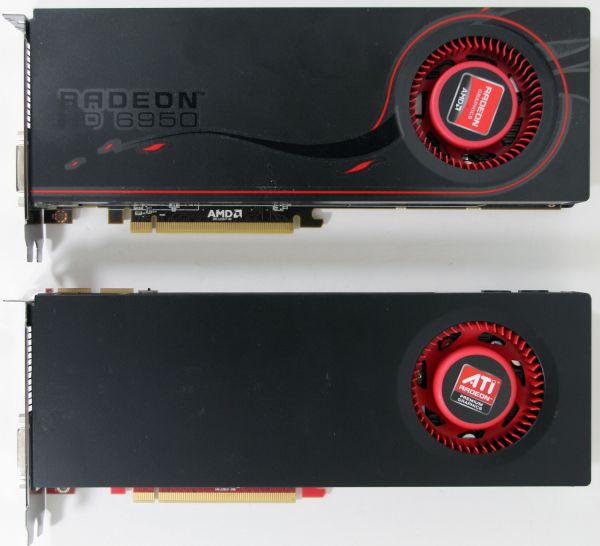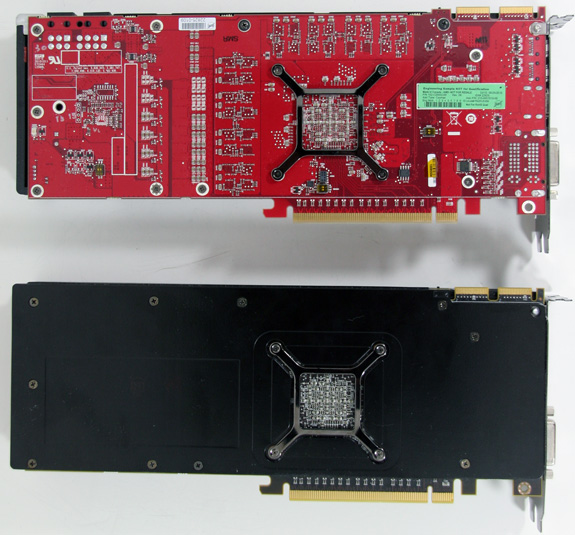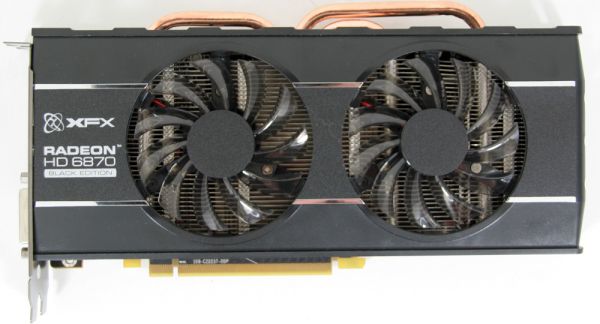AMD’s GTX 560 Ti Counter-Offensive: Radeon HD 6950 1GB & XFX’s Radeon HD 6870 Black Edition
by Ryan Smith on January 25, 2011 12:20 PM ESTMeet The Radeon HD 6950 1GB and XFX Radeon HD 6870 Black Edition
We’ll start our look at today’s cards with the headliner: AMD’s Radeon HD 6950 1GB. As we’ve previously established our 6950 is an engineering sample – perhaps an early one – so there’s not much to look at. Save for the kind of cosmetic defects you’d expect on an engineering sample, it’s for all practical purposes identical to the production 6950 2GB, and that’s intentional. AMD set out to make the 6950 1GB identical to the 6950 2GB other than the use of lower capacity GDDR5 chips, and this is what they have accomplished.

Top: 6950 2GB. Bottom: 6950 1GB Engineering Sample

Top: 6950 1GB Engineering Sample. Bottom: 6950 2GB
Since producing a 1GB card involves little more than replacing 2Gb memory chips with 1Gb memory chips, the true design innovations are going to come from AMD’s partners. Sapphire already has a 6950 1GB out with a custom cooler, and as AMD’s other partners get situated with 1GB cards we expect to see much of the same with them.
One item worth noting is that because our card is based on the reference design, it includes the BIOS switch at the top of the card. This means reference-based 1GB cards are going to have the same BIOS failsafe in them – however suitable BIOSes for the unlockers among you are another matter. Without some BIOS hacking (and possibly more), existing 6970 BIOSes are unsuitable as they’re meant for 2GB cards. Until such a time comes where a 6970 1GB BIOS can be developed, the 6950 1GB is not going to be a good card for unlocking. For the time being unlockers are going to want to stick to 2GB cards.
The Radeon HD 6950 1GB is launching with an MSRP of $259. At this time you can find reference-style 2GB cards for as little as $269, making the 1GB cards a rather simple $10 trade-off if you don’t mind mail-in rebates.
XFX Radeon HD 6870 Black Edition
Our second card of the day is XFX’s 2nd generation Radeon HD 6870 Black Edition (687A-ZDBC), the card that AMD originally proposed as the GTX 560 Ti’s competitor. Clocked at 940MHz core and 1150MHz (4.6Gbps data rate) memory, it runs at 40Mhz (4%) core and a 100MHz (9%) memory over the reference 6870. Overall this is a mild overclock, particularly as the 6870 is core-bound as opposed to memory-bound most of the time.
With such a mild overclock we had little reason to pay attention to the card, particularly once we completed our GTX 560 Ti benchmarking and saw that it was 10-20% faster than the stock-clocked 6870. Indeed it wasn’t until we tested the card that we saw something that grabbed our attention. Or perhaps I should say heard.
At the risk of spoiling the rest of our article, this card is for all practical purposes silent. At idle it’s only as loud as the noise floor of our GPU testbed, and at load – even under Furmark – it’s the same story. We measured 41.4dB at both idle and load, making it the quietest actively cooled mid-range card we have ever tested in our existing rig. Even the remarkably quiet GTX 460 can’t hold its ground to the 6870 Black Edition, it’s that quiet.
So what’s XFX’s secret? It’s much the same story as with the GTX 460. While the 6870 reference design uses a blower XFX is using an open-air cooler, specifically a double-fan cooler with 3 copper heatpipes that’s very similar to MSI’s Twin Frozor and Gigabyte’s Super Overclock cooler. Open-air coolers are already capable of being much quieter than blowers, and when done correctly a double-fan arrangement can be quieter than driving a single fan at higher speeds. Combining this highly effective cooler with the 6870’s Black Edition’s low TDP (~160W) results in a very quiet card that by all indications cannot be beaten at this point in time.
Rounding out the package, there are no real meaningful extras to discuss. Aside from some trinkets (stickers, case badges, etc), the only other piece of hardware in the box is a short CrossFire bridge. XFX has kept it simple: the only things that really matter are the card and XFX’s lifetime warranty.
The Radeon HD 6870 Black Edition doesn’t have a set MSRP, but it’s currently available for around $229 with a mail-in rebate, making it roughly $10 more expensive than a stock-clocked card. Or compared to XFX’s lineup, the non-Black Edition version of this card is a mere $4 less at $225; so you’re looking at a $4 factory overclock and $6 for a supurb custom cooler.












111 Comments
View All Comments
silverblue - Tuesday, January 25, 2011 - link
No. They already got roasted for doing it last time. Also, the 6870 Black Edition is an official AMD product that hasn't been shoved down Ryan's throat. So, whereas before all things may not have been exactly equal, they are now.The presence of the 6950 1GB in the 560 Ti review is quite natural as the 6950 2GB was already there, and besides which, until you overload that memory, the 6950 1GB performs pretty much the same as its 2GB brother, albeit a tiny bit faster in places - it's not cheating to include it as it's not an overclocked card. There's no other way you can handle it except to have the two AMD cards in separate articles to each other and not mention the 6950 1GB in the 560 Ti review (hardly sensible - we already knew it'd be almost identical to the 2GB variant), or not review the 6870 Black Edition at all. Also, think of the time it must've taken Ryan to handle these reviews - certainly doesn't take a day or so to do.
With overclocked cards, the situation is that the standard product is reviewed and, usually, the 3rd party offerings are reviewed together in a separate article in short order. I fully expect this to happen as it's normal for a site like Anandtech to do so.
If your beef is with the 6870 Black Edition, please remember that, as stated in the review, AMD fully intended it to be the 560 Ti's true competition, and that the 6950 1GB was due out in February. When it became apparent that the 6870 wasn't the answer, they released the 6950 1GB early. There's no sense in scrapping all those 6870 Black Editions, of which there has to be thousands, so AMD have not only brought out two cards at the same time, but offered two viable alternatives to nVidia's one. The only thing that AMD will suffer is lack of availability for those 6950s for the time being which is only natural for an accelerated launch, plus nVidia will undoubtedly lose some sales so well done on that.
ritalinkid18 - Wednesday, January 26, 2011 - link
Well said, GeorgeH...well said....QUOTE:
"There is no bias at Anandtech, only well documented arguments and conclusions that you're free to disagree with. If you want to abandon one of the best tech review sites on the planet in favor of one that panders to your personal delusions about the fuzziness of a multinational corporation, knock yourself out."
medi01 - Wednesday, January 26, 2011 - link
Yeah, I won't talk about cherry picked oced 460, but "forgetting iPhone in the pocket" on comparison pics where it would look very pale (much lower contrast) is quite remarkable.sebanab - Tuesday, January 25, 2011 - link
Dude give it a rest!Plus it's only fair that both makers got the same treatment...
Menetlaus - Tuesday, January 25, 2011 - link
Dude, this isn't the GTX560 Ti launch article. This is a picture of the market as you or I can go out and buy cards.I agree that the whole OC'd GTX460 "issue" was total bovine excrement from fanboys complaining that their poor nVidia was being compared to existing, non-reference cards that were wildly available at the time of the 460's launch.
That being said, the launch article for the GTX560Ti is one article down and contains nothing but reference cards in an effort to keep the whiners quiet.
SandmanWN - Tuesday, January 25, 2011 - link
Dudes, whatever. (You guys started it)The 460 article wasn't even about the 460. It was brought into the fray during an AMD release article. The only bovine excrement came from the drool of Nvidia fanboys that had the ridiculous notion that a cherry picked overclocked card delivered by Nvidia was allowed into a reference card release article for AMD. Which clearly drew red flags from those readers with common sense.
And not only that but the the writer couldn't even finish the friggin article the way he wanted to because he was spending his time doodling around with the Nvidia card. That was complete BS.
We tried to give some pointers on how it should have been handled.
1) Reference vs reference on product release articles.
2) Follow up articles with overclocked cards vs overclocked cards.
It was a real simple freaking concept.
Parhel - Wednesday, January 26, 2011 - link
Exactly. Nobody said that Anandtech shouldn't review OC'ed cards. The point was that OC'ed cards hand selected by AMD or Nvidia shouldn't be included in the launch article for their competitors new architecture. Had this card been included in the GTX 560 article, their would have been the same uproar as before.silverblue - Wednesday, January 26, 2011 - link
Yes, but there's a big difference between a majorly overclocked 3rd party card promoted by nVidia and a slightly overclocked original AMD card. I can see your point, though.7Enigma - Tuesday, January 25, 2011 - link
I haven't read this article yet (just finished the GTX 560Ti but wanted to say thank you for putting this article up. As many of us had asked for you properly kept the launch article about the card being launched and comparisons to stock cards, but in this article you are comparing other offerings including OC'd cards.That's the way it's meant to be done and I thank you.
Parhel - Wednesday, January 26, 2011 - link
Seconded.